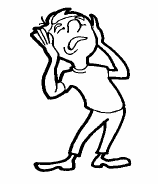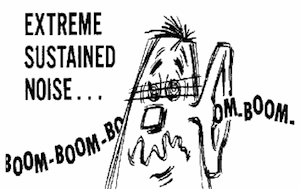Potential Deterioration in Hearing Due to Hearing Aid Usage
This past series of posts has posed the question as to whether hearing aids, especially those of high power, lead to further loss of hearing. In other words, does wearing hearing aids cause further hearing loss because of the high levels of amplification sometimes needed to overcome the hearing loss? Individual case reports, as well as results from clinical studies on larger populations over varying lengths of time, were summarized in previous posts.
Keep in mind that this question has been considered since the advent of electronic hearing aids {{1}}[[1]] Berry, G. The use and effectiveness of hearing aids. Journal of LaryngoIogy, 1939, 49,912-921[[1]], {{2}}[[2]] Holmgren, L. Can the hearing be damaged by a hearing aid? Acta Oto-Laryngologica, 1939, 28,440-449[[2]], and a number of attempts have been made to confirm or refute the possibility that amplification (especially overamplification), has led to further hearing loss {{3}}[[3]] Rintelmann, W.F., & Bess, F.H. High-level amplification and potential hearing loss in children. In F. H. Bess ed.), Childhood Deafness: Causation, Assessment and Management. New York: Grune and Stratton, 267-293, 1977[[3]].
Investigation Strategies
It has not been confirmed whether or not hearing aids cause further hearing loss. But, this does not mean that a cause/effect relationship has not been investigated. What follows is an attempt to show the approaches that have been used to determine this relationship.
Potential strategies in the general field of noise research (where this topic is most likely to be considered) traditionally use one of the following approaches: (1) retrospective studies of noise-induced permanent threshold shift (NIPTS); (2) investigation of experimentally induced reversible hearing loss (temporary threshold shift, TTS) in humans; and (3) studies of NIPTS, TTS, histology, and electrophysiology in laboratory animals {{4}}[[4]] Humes, L.E., & Bess, F.H. A test battery approach to the investigation of susceptibility to temporary threshold shift. Acta Oto-laryngologica, 1978, 86,385-393[[4]].
Despite the results of reported investigations of additional amplification leading to further hearing loss, the diversity of conclusions obtained has provided little to answer the question of whether or not hearing aids cause further hearing loss. Why might this be? Could it be that most have involved retrospective studies of audiometric threshold shifts in habitual hearing aid wearers? It is thought that to more fully understand the potential risk of overamplification to the hearing aid wearer all three of the strategies posted previously should be employed to their fullest capacity.
Because results from this trilogy of strategies do not exist, one is left to review overamplification from studies involving TTS (temporary threshold shift) and hearing aids. But, this approach, when evaluated in light of research in noise, does not answer the question, as will be explained.
The Use of TTS as an Index of Potential Damage
 Considerable literature exists relative to TTS (Temporary Threshold Shift). TTS is the transitory change (for the worse) in hearing threshold following exposure to somewhat intense sound. It was suggested at one time {{5}}[[5]] Temkin, J. Die schadigung des ohres durch larm und erschutterung. Mschr. Ohrenheilk. Laryngo-Rhinologie, 1933, 67, 257-299, 450-479, 527-553, 705-736, 823-834[[5]] that TTS following a short exposure to a moderately intense sound might provide a simple measure for estimating if noise-induced permanent changes in hearing threshold (NIPTS, noise-induced permanent threshold shift) would occur in response to longer and more intense exposures to sound. Although this hypothesis was formulated long ago, no well-defined relationship between TTS and NIPTS has yet been presented.
Considerable literature exists relative to TTS (Temporary Threshold Shift). TTS is the transitory change (for the worse) in hearing threshold following exposure to somewhat intense sound. It was suggested at one time {{5}}[[5]] Temkin, J. Die schadigung des ohres durch larm und erschutterung. Mschr. Ohrenheilk. Laryngo-Rhinologie, 1933, 67, 257-299, 450-479, 527-553, 705-736, 823-834[[5]] that TTS following a short exposure to a moderately intense sound might provide a simple measure for estimating if noise-induced permanent changes in hearing threshold (NIPTS, noise-induced permanent threshold shift) would occur in response to longer and more intense exposures to sound. Although this hypothesis was formulated long ago, no well-defined relationship between TTS and NIPTS has yet been presented.
However, it has been suggested that failure to define this relationship may be due to the index of TTS selected for use rather than the invalidity of Temkin’s original hypothesis {{6}}[[6]] Kraak, W. Growth of TTS and course of recovery for different noises: Implications for growth of PTS. Proc. int. cong. on noise as a public health problem, EPA Report. No. 550/9-73-008, 293-299, 1974[[6]]. Specifically, most early research used a TTS value measured at a specific post-exposure time (i.e., 2 minutes), and then measured the time for the hearing sensitivity to recover to pre-exposure levels. While this appeared suitable for measuring the temporary effects of noise on hearing, it was not found to be appropriate for measuring reversible hearing loss caused by excessive exposure to impulse, continuous, intermittent signals, or intermittent exposures to continuous noise. For example, for intermittent exposures to steady-state noise or exposures to impulse noise, a second TTS maximum occurs at post-exposure times from 1 hour to 10-12 hours. In other words, research indicated that no single TTS/recovery time relationship was adequate for all noise exposures.
Would it be useful to have a single TTS value applied universally to identify the temporary threshold reduction, and then the recovery time to pre-test conditions as an index of further damage to the hearing system? This would most likely be problematic because under conditions of prolonged continuous exposures to steady-state noise, TTS grows exponentially during the early stages of exposure until, at some time during the exposure, the TTS levels off in spite of further increases in exposure duration (at least up to 90 dB SPL), or essentially reaches an asymptote (ATS, Asymptote Threshold Shift). Once that asymptote is reached, it appears to be maintained for up to 40 hours. But, even though the TTS remains at this asymptote for long periods of time, the underlying dysfunction may not be constant throughout the exposure period. For example, recovery takes longer following 48 hours of exposure than 24 hours of exposure despite equivalent ATS values immediately following exposure.
Recovery from TTS has been suggested as a way to look at cochlear injury, or permanent hearing change {{7}}[[7]] Lawrence, M. Current concepts of the mechanism of occupational hearing loss. American Industrial Hygiene Association Journal, 1964, 25,269-273[[7]]. Support has been provided for this suggestion by detailed histological analysis of the cochlear hair cells, albeit in chinchillas {{8}}[[8]] Bohne, B. Safe level for noise exposure? Annals of Otology, Rhinology, and Laryngology, 1976, 85, 711-725[[8]].
Another critique of using the TTS paradigm as an index of irreversible injury to the cochlea comes from animal research where behavioral and histological data are obtained from the same ear. Results have ranged from good to poor correlations between audiometric threshold and cochlear damage. However, the correlation is better for frequencies above 1000 Hz than for frequencies below 1000 Hz. TTS in the latter tend to underestimate underlying cochlear damage.
To summarize, if the TTS paradigm is to be used to relate TTS to PTS, certain limitations must be recognized:
- Measures of TTS based on a single TTS value obtained at a particular post-exposure interval are of little value, and
- Measures of TTS obtained for frequencies below 1000 Hz tend to underestimate underlying cochlear damage.
This implies that TTS is limited as a measure of reversible hearing loss. If that is the case, what else could be used to draw this relationship?
Time Integral of TTS
This is an index derived from TTS data, but one that considers the entire pattern of TTS growth and recovery. Threshold shift is measured periodically throughout the growth and recovery stages of TTS, and the time integral of TTS is then calculated for the period extending from onset of noise exposure to completion of recovery {{9}}[[9]] Kraak, W. Growth of TTS and course of recovery for different noises: Implications for growth of PTS. Proc. int. cong. On noise as a public health problem, EPA Report. No. 550/9-73-008, 293-299, 1974[[9]]. The result is known as the integrated temporary threshold shift (ITTS).
All things being equal, the slower the recovery, the greater the ITTS. Recall that recovery from TTS has been found to relate more closely to underlying damage than to a single post-exposure measurement of TTS. Thus, ITTS would appear to be a more valid estimate of cochlear dysfunction than previous measures of TTS obtained at single post-exposure intervals.
In summary, ITTS is the preferred measure to be derived from use of the TTS paradigm. Note, however, that the same general TTS paradigm is used, but with the quantification of the results in terms of ITTS as opposed to TTS at specified time intervals (2, 30, or 60 seconds) being the difference.
Through extensive investigation, Kraak and his associates have established a direct relationship between ITTS and the physical parameters associated with noise exposure. The latter is referred to as the noise dose (Dn). Dn is the time integral of the A-weighted sound pressure in Pascals calculated over the entire exposure period. Because ITTS from hearing aid use seems to be governed by the same factor (Dn) as other forms of ITTS, a next step would be to establish the relationship between ITTS and NIPTS.
This process is complicated by the fact that the hearing loss from amplified sound is often due to aging as well as to noise exposure. As a result, isolation of these two contributors to PTS should be modeled to determine the amount related to the greater amplification (noise exposure) as opposed to that from the aging process. Modeling appears to be fairly good, with the understanding that it relates primarily to 4000 Hz, the frequency most affected by threshold shifts.
Next Week: Predicted PTS (Permanent Threshold Shift) from hearing aid use.







I’m not a scientist or technician–I’m a user, and I can certainly report that many environmental sounds are magnified uncomfortably by even my high-end HAs. I routinely turn them OFF before stepping out of the car at a Interstate Highway rest stop–the road noise from passing trucks and cars is enormous! (I still plan to get a decibel reader and do some tests.) The other place where noise is unpleasantly and unexpectedly loud is in public rest rooms where the modern high pressure toilets flushing and the tiled rooms make for tremendous and very loud sounds.
One must still play a part in “managing” one’s own hearing devices. Just because your HAs can “automatically adjust for sound stimuli” doesn’t mean they will do so with total success for your ears! Of sudden loud sounds are detrimental to the cilia in our ears, then these loud noises have to be trouble.
Your experiences are not uncommon. If you have hearing aids that are programmable, and if you have not mentioned these issues to your dispenser, I would suggest that you schedule an appointment and ask him/her to work with you to reduce the problems you are experiencing.